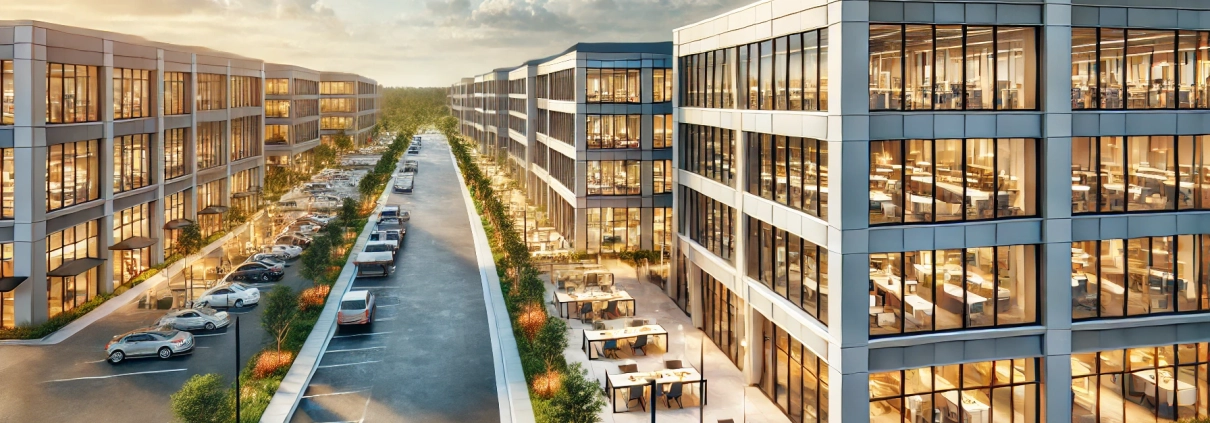Lease Depth
The distance measured between the building window line and the building core wall’s exterior side.
Putting ‘Lease Depth’ in Context
Horizon Partners, a real estate investment firm specializing in core-plus office acquisitions, recently acquired The Meadowview Office Park, a suburban office property in Orlando, Florida. The property comprises three Class B+ office buildings, totaling 150,000 square feet of rentable space. Built in the early 2000s, Meadowview features a mix of modern amenities, including energy-efficient glass façades and flexible floor plates catering to midsize tenants.
During the due diligence phase, Horizon Partners evaluated various design characteristics to assess the marketability and potential value of the property. A key consideration was lease depth—the distance between the window line and the core wall on each floor.
Lease Depth Considerations
The lease depth at Meadowview Office Park measures 45 feet, which falls within the standard range of 40–50 feet for suburban office properties. This depth supports efficient tenant layouts, allowing for a variety of office configurations, such as:
- Private offices along the window line, ensuring access to natural light.
- Open floor plans for collaborative teams, with workstations arranged in the interior zone.
- Hybrid layouts, blending open areas and enclosed meeting spaces.
The property’s lease depth was also a critical factor in analyzing tenant retention risks. Smaller tenants occupying single-floor suites favored the building’s depth, as it minimized wasted space and maintained natural light throughout the premises. Additionally, the efficient lease depth allowed the leasing team to market the property as ideal for tenants seeking 5,000 to 20,000 square feet—perfect for Orlando’s growing professional services sector.
Financial Impact of Lease Depth
To evaluate the impact of lease depth on leasing potential, Horizon Partners performed a comparative analysis. Similar properties in the Orlando market with lease depths exceeding 50 feet often struggled to lease interior spaces due to reduced daylight exposure. As a result, those properties experienced longer vacancy periods and higher tenant improvement costs to accommodate custom layouts. In contrast, Meadowview’s manageable lease depth contributed to its above-market occupancy rate of 92 percent at acquisition.
Over the first year of ownership, Horizon Partners achieved an NOI of $2.5 million, supported by stable rents averaging $24 per square foot. The balanced lease depth also minimized operational risks by making tenant improvements more predictable and cost-effective.
Conclusion
Lease depth plays a significant role in determining the functionality, tenant appeal, and financial performance of office properties. At Meadowview Office Park, the optimal lease depth of 45 feet enhanced leasing flexibility, helped secure long-term tenants, and supported Horizon Partners’ core-plus investment strategy. This case highlights how understanding lease depth can directly impact both marketability and investment returns.
Frequently Asked Questions about Lease Depth in Commercial Real Estate
What is lease depth?
Lease depth is the distance measured between the building’s window line and the exterior side of the building’s core wall.
Why does lease depth matter in office properties?
Lease depth affects how efficiently a space can be configured. It influences natural light access, tenant layout options (e.g., open floor plans vs. private offices), and the overall appeal of the space to prospective tenants.
What is considered a standard lease depth for suburban office buildings?
According to the case of Meadowview Office Park, a standard lease depth typically ranges between 40 and 50 feet for suburban office properties.
How did lease depth impact Meadowview Office Park’s leasing performance?
With a lease depth of 45 feet, Meadowview supported a variety of tenant layouts and natural light access, contributing to an above-market occupancy rate of 92% at acquisition.
What leasing challenges are associated with excessive lease depth?
Properties with lease depths exceeding 50 feet may struggle to lease interior spaces due to reduced daylight exposure, leading to longer vacancy periods and higher tenant improvement costs.
What types of tenants benefit from efficient lease depth?
Midsize tenants, such as professional services firms seeking 5,000 to 20,000 square feet, benefit from efficient lease depth due to flexible space layouts and access to natural light.
Click here to get this CRE Glossary in an eBook (PDF) format.

